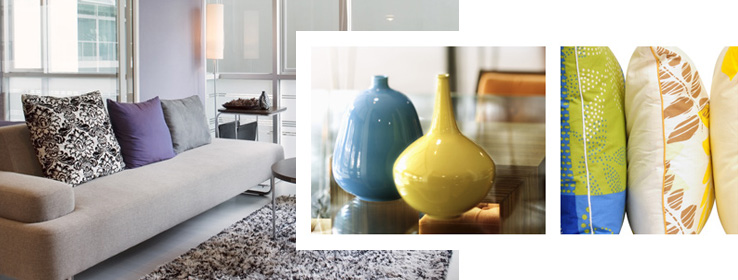The economy spins the color wheel in mysterious ways.
Your home's value is in the tank … you haven't had a pay raise since your pay cut two years ago … you can't even bear to look at your 401(k) statement … and economists keep warning of a double-dip recession.
What's a color-conscious consumer to do? Gravitate to drab, practical hues that fit the times we're living in? Or seek a mood-lifting boost from exuberant orange or sunny yellow?
Actually, we're doing both, according to color experts. While we've all heard that hemlines rise and fall with the stock market, color palettes have a much more complicated relationship with the economic climate.
"People have different responses to the economy," says Michelle Lamb, home furnishings forecaster for The Trend Curve. "Some are saying ‘yes' to bright colors, and some are saying ‘yes' to subdued colors."
"I see two extremes," agrees Jackie Jordan, director of color marketing for Sherwin-Williams. "While some consumers respond to tough times by cocooning and not straying too far from practical colors that they think will have longevity, others defy them by choosing bright, lively colors that lift their spirits."
And a double-dip recession, if it comes to that, isn't going to change things. "It is what it is," Jordan says. "We haven't come out of the first recession - a double-dip isn't going to make a difference." However, economic factors do affect color trends for some items more than others. "For big purchases, people tend to be more practical," Jordan says. "For little things, they're more impulsive."
Colors for larger upholstered pieces such as sofas and chairs have definitely gotten more subdued, Lamb says. "The economy has been a huge influence. Color was on a tear for upholstery. Now we're moving back to neutrals, because of the economy."
Cash-strapped consumers want big-ticket items to have longevity, she says. "People perceive that a neutral sofa will stay in style longer than a boldly colored one." But even neutrals change, she notes. "A neutral from 10 years ago isn't what a neutral is today." While chameleon neutrals with undertones that shift and change remain popular, "sea salt" neutrals are ascending, she says.
And deep jewel tones, such as navy blue, evergreen, deep purple and dark red also are doing well in this struggling economy, Lamb says. "They're perceived as classic."
Demographics also shape the way economic factors influence color choices. Older consumers are more likely to limit themselves to colors they consider practical, Jordan says. "The younger generation is going to buy color that makes them feel good, usually on the bright side of the spectrum."
But all consumers face fewer fashion-forward color choices than they had before the recession. "In a bad economy, rather than taking a risk, manufacturers will not introduce new colors but will stick with colors that are already selling well," Jordan says.
The cosmetic industry has its "Lipstick Index," a well-known financial barometer, which demonstrates that cosmetic sales (lipsticks in particular) rise as the economy slows down, because women are more motivated to express themselves with small purchases when they can't afford big ones. There's a parallel effect in interiors, Jordan says. Those who can't spring for a new couch or countertop can splurge on a pillow, vase or coat of paint in a fun new color.
In fact, buying something in a color you just plain love may be the most practical purchase of all. All Things Frugal, a website that identifies itself as "home of the penny pincher and tightwad tidbits," advises readers to choose hues they truly like rather than perceived safe ones: "Colors you enjoy looking at are practical because you'll be happier with your purchase and waste less money replacing it."
So if you - or your client - has a hankering for a fresh new color, go ahead and repaint that room or splurge on those accent pillows. It's a good way to banish the recession blues.








